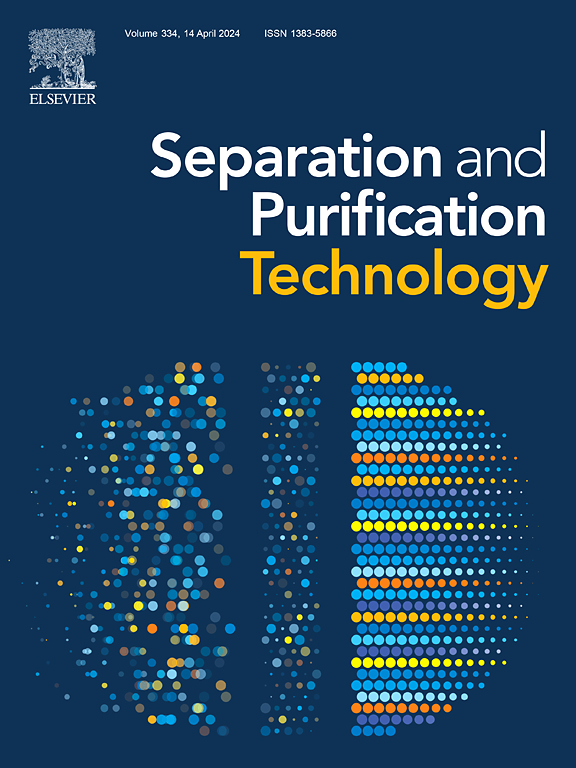Super-elastic compressible chitosan/chlorella pyrenoidosa-graphene biomass aerogel with accordion-like structure for all-weather and high-efficiency cleanup of crude oil spills
IF 8.1
1区 工程技术
Q1 ENGINEERING, CHEMICAL
引用次数: 0
Abstract
Crude oil spills represent a major environmental catastrophe in marine ecosystems. The high viscosity of crude oil significantly hampers its ability to infiltrate traditional porous adsorbent materials. Fortunately, the viscosity of crude oil is highly sensitive to temperature. In this work, a self-heated aerogel, powered by both solar and Joule heating, was designed as an all-weather adsorbent for continuous crude oil absorption by markedly reducing its viscosity. The chitosan (CS)/chlorella pyrenoidosa (CP)-Graphene (GO) biomass aerogel featuring an accordion-like structure and super-elastic compressible, was first fabricated using a directional freeze casting technique. It was then subjected to surface treatment with GO/carbon nanotube (CNTs) and methyltrimethoxysilane (MTMS) to impart Joule heating effects and hydrophobicity, respectively (named H-CS/CP-G). The special accordion-like structure endows it with excellent mechanical properties, the height recovery rate of the H-CS/CP-G biomass aerogel can reach 95 % after 10 cyclic compression experiments. The H-CS/CP-G biomass aerogel can rapidly attain 79.4 °C under one sun exposure, and similarly, it can quickly heat up to 79.6 °C when a 6 V voltage is applied. This temperature responsiveness enables efficient all-weather cleanup of crude oil. More importantly, the H-CS/CP-G biomass aerogel is capable of absorbing crude oil up to 25 times its own weight and possesses a recyclability of 90.7 % after 10 absorption-extrusion cycles. When integrated with a vacuum pump system, the biomass aerogel facilitates the continuous extraction of crude oil from the water surface. Therefore, through the synergistic effect of photothermal and Joule heating, along with the construction of a unique accordion-like structure, the H-CS/CP-G aerogel, with the assistance of a pump absorption device, can achieve efficient and continuous separation of high-viscosity crude oil in all weather conditions. The prepared all-weather biomass aerogel, with low cost, easy preparation, environmental friendliness, and high efficiency, offers a sustainable and effective solution for the cleanup of crude oil spills.
具有手风琴状结构的超弹性可压缩壳聚糖/小球藻-石墨烯生物质气凝胶,用于全天候高效清除原油泄漏
原油泄漏是海洋生态系统的重大环境灾难。原油的高粘度严重阻碍了其渗透传统多孔吸附材料的能力。幸运的是,原油的粘度对温度非常敏感。在这项工作中,一种由太阳能和焦耳加热驱动的自加热气凝胶被设计为全天候吸附剂,通过显着降低其粘度来连续吸收原油。壳聚糖(CS)/核核小球藻(CP)-石墨烯(GO)生物质气凝胶具有手风琴状结构和超弹性可压缩性,首次采用定向冷冻铸造技术制备。然后用氧化石墨烯/碳纳米管(CNTs)和甲基三甲氧基硅烷(MTMS)对其进行表面处理,分别获得焦耳热效应和疏水性(命名为H-CS/CP-G)。特殊的手风琴状结构使其具有优异的力学性能,经过10次循环压缩实验,H-CS/CP-G生物质气凝胶的高度回收率可达95 %。H-CS/CP-G生物质气凝胶在一次阳光照射下可以快速达到79.4 °C,同样,当施加6 V电压时,它可以快速加热到79.6 °C。这种对温度的响应能力使其能够全天候高效地清理原油。更重要的是,H-CS/CP-G生物质气凝胶能够吸收高达自重25倍的原油,经过10次吸收-挤压循环后,可回收利用率为90.7 %。当与真空泵系统集成时,生物质气凝胶有利于从水面连续提取原油。因此,通过光热和焦耳加热的协同作用,加上独特的手风琴状结构的构建,H-CS/CP-G气凝胶在泵吸收装置的辅助下,可以在全天候条件下实现高粘度原油的高效连续分离。所制备的全天候生物质气凝胶具有成本低、制备简单、环保、高效等特点,为原油泄漏清理提供了可持续、有效的解决方案。
本文章由计算机程序翻译,如有差异,请以英文原文为准。
求助全文
约1分钟内获得全文
求助全文
来源期刊

Separation and Purification Technology
工程技术-工程:化工
CiteScore
14.00
自引率
12.80%
发文量
2347
审稿时长
43 days
期刊介绍:
Separation and Purification Technology is a premier journal committed to sharing innovative methods for separation and purification in chemical and environmental engineering, encompassing both homogeneous solutions and heterogeneous mixtures. Our scope includes the separation and/or purification of liquids, vapors, and gases, as well as carbon capture and separation techniques. However, it's important to note that methods solely intended for analytical purposes are not within the scope of the journal. Additionally, disciplines such as soil science, polymer science, and metallurgy fall outside the purview of Separation and Purification Technology. Join us in advancing the field of separation and purification methods for sustainable solutions in chemical and environmental engineering.
 求助内容:
求助内容: 应助结果提醒方式:
应助结果提醒方式:


